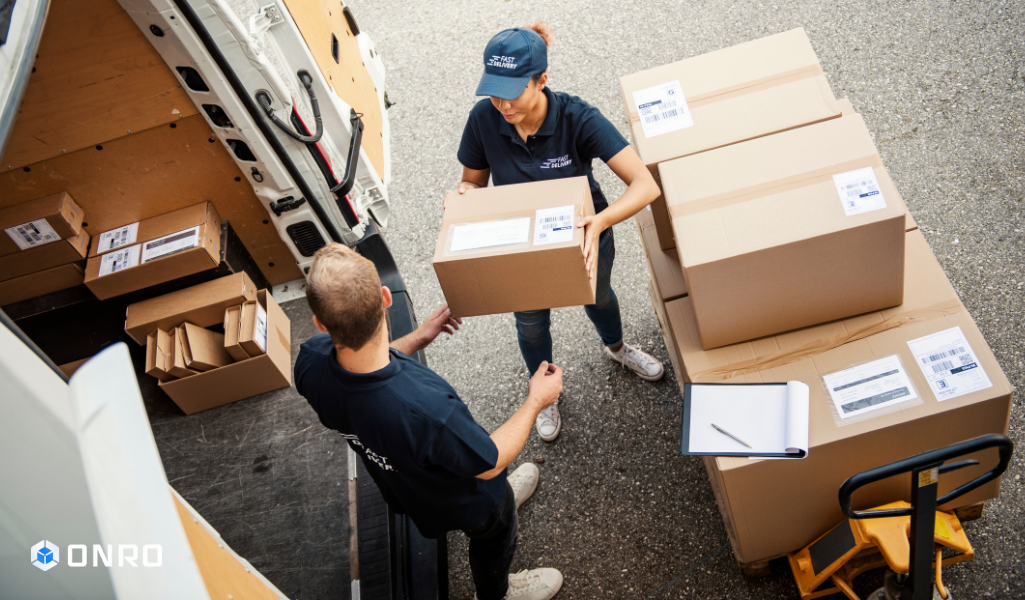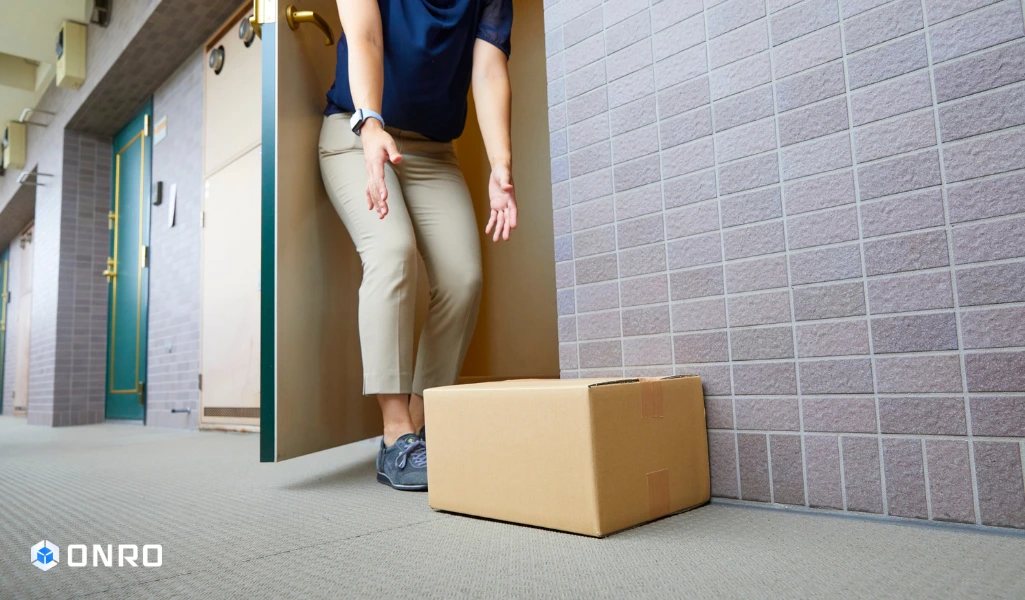The last-mile delivery strategy refers to all techniques and technologies used to implement an optimized delivery phase from distribution centers to the consumer’s home, with incentives such as cost reduction and faster service to satisfy the customer.
Key Takeaways
-
Last-mile delivery accounts for over 50% of total logistics costs, making optimization a critical priority.
-
An adequately planned last-mile delivery strategy could include: AI route planning, real-time tracking, and a dynamic delivery decision system.
-
Demand is forecasted using predictive analytics, and as such, delays in the delivery service are eliminated for an efficiently functioning system.
-
In scenarios where there is sudden demand increase, crowdsourcing and hybrid delivery models allow for the necessary scalability.
-
Parcel transportation is faster with the use of micro-fulfillment centers and smart lockers, easing the harsh condition of missed deliveries.
-
Tracking carbon footprints with all manner of thought poured into eco-friendly options gives yet another advantage to the logistical sector in greener processing.
-
With recruitment and training of drivers for delivery safety, monitoring ensures delivery credibility.
-
The upcoming age of 2025 is going to be worthy of savings, promises made, and eventually businesses converted into advanced software at Onro.
Last-mile delivery now accounts for over 50% of total logistics costs, according to Capgemini and Insider Intelligence. Without a solid last-mile delivery strategy, companies look to face rising costs, missed deadlines, lost customer trust, and the like. This post investigates 13 strategies that will be expert-aided, and emerging technologies will provide the framework for efficient last-mile delivery and scaling.
Try Onro for Free
Get your free access to the Onro All-in-one Last Mile Delivery Software.
What Is a Last-Mile Strategy?
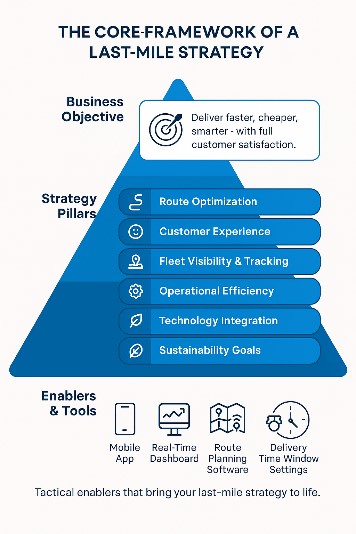
The last-mile strategy involves techniques developed to streamline last-mile logistics, where most of the customers’ interaction takes place. As this strategy allows one to put the customer first, it is time to speed up and make delivery more efficient and convenient for them. By 2025, such types of customer experience engineering shall be the bare minimum to sustain a brand.
Examples of Last-Mile Strategy Optimization Tactics
So, these digitalized delivery solutions, through mapping, optimize the route selected for the shortest and most fuel-efficient option in real time with alerts from:
- Traffic incidents such as roadworks or closures
- Weather conditions intervening with delivery time
- Customer preferences like payment gateway, delivery, contactless delivery, or time slots
Yet, vehicle real-time tracking is also a key individual function to enhance fleet visibility while providing the dispatcher manager with oversight of routes, vehicle performance, and driver behavior.
Why the Last-Mile Strategy Matters in 2025
Controlling Rising Costs and Meeting Speed Expectations
The last-mile delivery now constitutes 50 to 60% of transportation expenses. These costs remain the most disbursed, thereby making cost efficiency the number one consideration for profitability. On the other hand, the modern-day customer wants goodies dropped fast and well, sometimes within the same-day delivery or next day delivery. Intelligent routing and tracking in real-time, given by Onro last-mile delivery software, allow all deliveries to be optimized by companies-they then reduce fuel expenses and ensure on-time performance to build trust and loyalty.
Driving Sustainability and Social Responsibility
The environmental factors have affected last-mile delivery strategies at many levels. Onro supports actions towards green measures through route optimization that reduces carbon emissions, especially in ancillary integration with electric and green fleet operations. It thus becomes persuasive for businesses to fall in line with these sustainability commitments while aligned with variable consumer pressure for responsible business operation.
Scalable Last-Mile Tech for Local Operators
Some of the larger logistics companies like FedEx and Amazon try to use technologies to eliminate inefficiencies in last-mile delivery. Onro has now brought this technology to the small independent operators for faster, smarter, and greener deliveries, route optimization, AI dispatch, and local-hub management, all rolled into one.
Solving Customer Pain Points of Delays and Inefficiencies
Delayed delivery, poor communication, and shaky services: Customers have mostly become discouraged with such occurrences that have damaged the brand. Onro enables real-time visibility through automated delivery notifications and analytics. This allows a brand to take a proactive view in resolving matters before they come into being, increasing transparency as well as customer satisfaction: two important elements of brand-building.
Enhancing Inventory Management and Reliability
Onro is integrated with inventory systems, so it matches deliveries with actual stock levels. Hence, it prevents delivery mistakes and prevents overstocking. This synchronization boosts customer confidence and supports seamless shopping experiences.
Creating Competitive Advantage and Unlocking Growth
Once perfected, last-mile logistics converts into market differentiation where one company begins to serve a sector that has very much been neglected. The scalable platform on Onro will grow alongside your business efforts in creating new customers through reliable yet inexpensive delivery offerings.
Aligning Strategy with Customer Expectations for Long-Term Success
Onro delivers a last-mile delivery experience according to changing customer expectations, making businesses more efficient, greener, and more relevant. This alignment keeps the brand relevant amid the ever-changing cosmopolitan world of ecommerce.
Core Pillars of an Effective Last-Mile Strategy
A well-implemented last-mile strategy can give rise to improvement in efficiency, reduction of costs, and promotion of brand relationships. Key constituents of a delivery system that produce a seamless customer experience and competitive advantage must be taken into account.
Route Optimization and Dynamic Planning
Knowing the customer’s priorities will help effectuate the last-mile strategy, whether they are speed, flexibility, or communication. Artificial intelligence and machine learning helped route planning software improve delivery routes, considering real-time weather and traffic conditions. These dynamic systems instantaneously change without any delay when there are sudden orders or route changes, keeping empty miles to a minimum and fuel to a maximum, along with high delivery speed and reliability.
Real-Time Tracking and Transparency
In an ideal world, delivery-based systems should have real-time tracking at their core. The status of delivery offers the opportunity for predictability and, consequently, interventions can be made to avoid unnecessary delays. Transparent operations in the delivery flow aid in customer satisfaction as well, by keeping all parties informed as to the status of the delivery.
Customer Communication
As far as timely last-mile delivery is concerned, there must be clear communication. Customers during ordering expect constant updates and notifications. Any delivery delay or late notification will frustrate the customer. Therefore, there must be communication channels created to nurture trust among customers and thereby with the brand image.
Driver Empowerment and Performance Monitoring
A varied fleet uses strategic partnerships with third-party logistics and crowd-sourced delivery models so that it is more flexible and can cover a larger region. Technology-based systems are implemented for driver location tracking and performance tracking so that delivery operations are made easy while maintaining extremely high service standards.
Sustainability and Green Logistics
The present last-mile strategies ensure sustainability in courier service by imposing route optimizations that tend to minimize emissions and fuel consumption. Also, green practices have been considered recently as a means to achieve environment-related goals, with companies beginning to associate delivery with socially responsible values.
Smart Warehousing and Micro Fulfillment
The last-mile delivery can be one step higher in perfection while merging data analytics on the supply chain and fulfillment. Being closer to the consumer via micro-fulfillment, the delivery time will be shorter, leaving options to be scaled and adapted to prevailing market demands.
Try Onro for Free
Get your free access to the Onro All-in-one Last Mile Delivery Software.
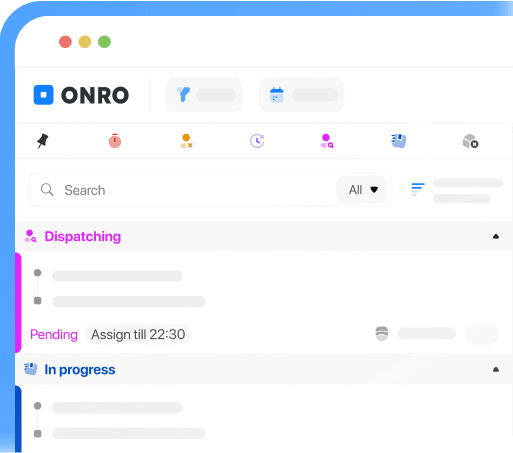
13 Last-mile strategy
Last mile optimization holds a unique place in courier services, having to maintain its balance among efficiency, satisfaction, and sustainability. Here are 13 winning suggestions along with possible high-end technologies and operational best practices for powering your delivery operations using Onro software.
| Strategy | Key Features | Why It Matters for New Businesses | Who Benefits Most | |
|---|---|---|---|---|
| 1 | Route Optimization | Smart routing via time, traffic, vehicle load | On-time, eco-friendly, cost-saving delivery | Firms with fluctuating delivery volumes |
| 2 | AI/ML Predictive Routing | Real-time AI-based route adjustments | Low cost, accurate ETA, better customer trust | SMEs, e-commerce, urban deliveries |
| 3 | Predictive Analytics | Demand prediction, bottleneck prevention | Competitive speed, improved decision-making | Seasonal/erratic delivery businesses |
| 4 | Live Tracking and ETA | Real-time GPS and notifications | Builds trust, reduces customer queries | Customer-focused, dispatcher-driven firms |
| 5 | Crowdsourced Delivery | On-demand gig drivers | Agile delivery without hiring overhead | Seasonal/spiky order flow businesses |
| 6 | Hybrid Delivery Network | Combines fleets, drones, gig, AVs | Max coverage with minimal investment | Rapid-scaling startups |
| 7 | Drones and AVs | Automated, congestion-free delivery | Future-ready, urban/remote access | Urban or remote delivery companies |
| 8 | Micro-Fulfillment Centers | Local mini-warehouses near customers | Fast delivery, low warehousing cost | Dense city markets, low-inventory firms |
| 9 | Smart Lockers | Self-service pickup points | Solves missed deliveries, user-friendly | Urban areas, busy-schedule customers |
| 10 | Contactless/Paperless Delivery | ePOD, photo proof, e-signature | Enhances safety, speed, trust | Safety-aware, customer-centric firms |
| 11 | Sustainable Practices | Green routing, eco packaging | Builds goodwill, meets regulations | CSR-focused, eco-conscious firms |
| 12 | Carbon Footprint Monitoring | Emission tracking dashboards | Aligns with green goals, brand trust | Environmentally responsible enterprises |
| 13 | Driver Recruitment and Training | AI feedback, ongoing safety training | Reduces risk, boosts brand credibility | Quality-driven delivery businesses |
1. Last Mile Delivery Route Optimization
Some factors considered by refined algorithms for last-mile routing include delivery time windows, traffic conditions, order priority, weather, and vehicle capacity.
Cantered routes save fuel, cut down on driver idle time, and diminish the waste of resources, opening up massive opportunities for the delivery firm to save while also benefiting the environment.
Why It Matters for New Businesses
While route optimization will essentially use that excuse to make simultaneous on-time deliveries with the professionalism whose standards and expectations have increased in recent times, it also will uphold green concerns on minimizing the carbon footprint.
Who Benefits Most
Probably, those types with fluctuating delivery volumes and having a shape undergo route optimization the most among the ones that fluctuate in delivery volumes and have a shape. Zone-based route planning and geofencing would probably be the best tools for change management in the way deliveries are orchestrated and would also help with fleet visibility.
2. AI/ML-Based Predictive Routing
These learning algorithms allow companies to set last-mile deliveries on designed routes where some delay factors may come into play- traffic or weather disruptions-with delivery window constraints.
Routing is done as follows:
- It considers the various delay factors such as traffic or weather disruptions where routing update takes place via AI/ML in real-time, and
- A route is optimized considering the delivery priorities and constraints to make sure arrivals are within given thresholds.
Why It Matters
- Better route planning means lower fuel consumption and wire downtime, which in turn reduces operational costs.
- Accurate ETAs help build reputation and trust among customers.
- With their real-time updates, companies can take action right away when anything unusual occurs, hence building their reputation.
Who Benefits Most
- Small and medium courier companies
- E-commerce Companies
- Urban delivery services
- Logistics managers
- Firms focused on sustainability
3. Predictive Analytics in Logistics
One of the key things that an enterprise can do is demand estimation, bottleneck detection, and route adjustment before bottlenecks occur, given a dataset of past deliveries. Hence, in this courier business model, the present traffic and weather data are analyzed by predictive analytics, and dynamic routing is prepared to execute the delivery. This will avoid the potential delays and can also provide delivery support resources by predicting the problems which are expected to occur.
Why It Matters for New Businesses
Start-up delivery services can use predictive analytics for decision-making, enhance customer satisfaction by means of precise ETAs, and speed up delivery operations as a measure to remain competitive in these rapidly moving markets.
Who Benefits Most
This is most beneficial to any business undergoing some sort of seasonal change in demand or having erratic delivery systems, which then require planning and risk minimization provided by predictive analytics.
4. Order Live Tracking and ETA
Their whereabouts can be tracked by both the customers and dispatchers through live tracking, and on-site exact ETAs can be acquired. Auto notifications run throughout the entire delivery process to update all concerned.
With this view in transparency, the customer will feel happy as all guessing and missed deliveries will be nonexistent, whereas the business resolves any delays or concerns professionally.
Why It Matters for New Businesses
While undertaking the building of a delivery business, live-tracking will immediately provide a trusting environment between the customer and the business, reduce customer queries, and give customers more leverage in securing an established working relationship for dependable service.
Who Benefits Most
Live tracking serves businesses that value good customer service and also, want to grow in an unequaled delivery environment. It also permits dispatch teams to reroute their drivers in real-time.
5. Crowdsourced Delivery
During peak demand periods, businesses may consider gig workers as a way to float the delivery team while not engaging them on a full-time basis.
The crowdsourced deliveries are flexibly adaptive to address any sudden spike in orders. This model goes quite well with traditional fleet management to ensure a quality service.
Why It Matters for New Businesses
This sort of delivery mechanism allows startups to build delivery capability, extended coverage, and the capability to adapt highly to market demand. The end effect, in turn, becomes positive for competition and customer satisfaction.
Who Benefits Most
Crowdsourcing becomes extremely beneficial in companies facing seasonal peaks or with irregular order flow because of the ability to rely on a large and diverse set of drivers without incurring permanent staffing costs.
6. Hybrid Delivery Networks
Having a flexible delivery arrangement mediated by any combination of seemingly crowd-sourced drivers, autonomous vehicles, drones, and conventional fleets into delivery orchestration platforms for full visibility over the fleet and seamless interaction. The system provides the ability to ramp up and down based on demand and optimize resource usage.
Why It Matters for New Businesses
Hybrid networks enable new delivery companies to maximize coverage and efficiency without major upfront capital costs.
Who Benefits Most
Those need to scale courier operations fast and efficiently in dynamic markets.
7. Drones and Autonomous Vehicles (AVs)
A huge efficiency gain presents itself for package delivery in the potential of drones and AVs in passing through traffic congestion and delivering straight to the customer.
Such methods decrease delivery times and improve service levels by reaching particular places where conventional vehicles cannot go.
With the constraint of regulations and the logistic conundrum, companies now have to be more and more careful about how they maneuver around such issues as airspace restrictions and safety considerations.
Why It Matters for New Businesses
Investments in drones and AVs will see a startup become not only ‘future-proofed’ in its operations but able to use advanced delivery methods within hybrid fleets as a competitive advantage.
Who Benefits Most
Companies working in urban congestion or remote areas will be those best served in incorporating drones and AVs into their delivery networks.
8. Micro-Fulfillment Centers
These fulfillment centers, also called urban micro-fulfillment centers, are just a name for small warehouses surrounded by the homes of customers to keep stocks inside.
Having an immediate store means fewer working hours, longer delivery period-days in the case of delivery and super-fast handling of inventories with short deliveries and cheap transports.
Why It Matters for New Businesses
This way, micro-fulfillment centers allow startups to provide gigantic hit delivery to customers while maintaining low inventory to reduce warehousing expenses.
Who Benefits Most
The last mile is best carried out by micro-fulfillment centers in last-mile deliveries at an intensity and speed suited to businessmen in extreme urban markets or densities.
9. Smart Locker Systems
The smart lockers are secured, self-service pickup points located in accessible public areas or inside gated residential complexes.
It is an alternative delivery method available to customers other than direct delivery, thereby reducing problems with missed deliveries and increasing overall efficiency.
Integration with smartphone apps and access codes furthers security and convenience for the user, minimizing the number of failed delivery attempts and conserving business time and money.
Why It Matters for New Businesses
Introducing new delivery services with lockers designed to improve customer experience and alleviate or manage last-mile challenges provides reliability and cost-effectiveness to operational procedures.
Who Benefits Most
Businesses that serve areas in the cities or clients with very untidy schedules greatly benefit by providing smart lockers as a second chance at delivery.
10. Contactless and Paperless Delivery
Minimal to zero physical contact is thus required during the process of cash-and-carry delivery, and the electronic proof of delivery (ePOD) system may provide testimony.
This creates a new rise in customer safety and rapidly confirms delivery while reducing paperwork.
High-end ePOD technologies provide for sending photos as proof of delivery, geostamping, taking customer notes, and receiving electronic signatures for delivery confirmation with maximum accuracy and security.
Why It Matters for New Businesses
Acceptance and trust from customers, efficient work within the businesses, and minimizing margin for errors.
Who Benefits Most
Companies willing to implement new delivery systems that maximize customer trust and adhere to health and safety regulations will find themselves in this area of contactless delivery.
11. Sustainable Practices
If poorly designed, the last-mile delivery can be very harmful to the environment. This includes carbon footprint sources from the electric, hybrid, or normal vehicles used, delivery routes, and road infrastructure.
Environmentally friendly packaging technologies try to reduce buffer waste. Carbon footprint assessment tools help monitor the environment so that daily activities can be carried out under green ambit guidelines.
Why It Matters for New Businesses
Last-mile delivery that is sustainable brings goodwill to any business while fulfilling mounting legal requirements and paving the way for consumers who would like to conform to such satisfactions in the near future.
Who Benefits Most
It mainly benefits companies with a past record of corporate social responsibility, plus the consumers who value green brands.
12. Carbon Footprint Monitoring
Tracking and analyzing fleet emissions and fuel consumption in real time is considered a crucial element.
Therefore, the firms are being helped to satisfy their sustainability KPIs and lessen their environmental impact.
Instantaneous carbon monitoring is available on the dashboard, which provides the insight needed to optimize activities for environmental friendliness and to support green-logistics goals.
Why It Matters for New Businesses
Integration of carbon footprint monitoring shows an organization-wide commitment to sustainable practices, thus aligning with a global trend in courier services and hence garnering consumer faith.
Who Benefits Most
Any enterprise interested in on-brand greener operations to enhance its image through environmental responsibility.
13. Driver Recruitment and Training
Attracts R&D, recruitment of delivery team, and ongoing enhancements keeping drivers safe, enhancing service quality, and mitigating hazards. Giving real-time feedback and targeted training through AI-based driver performance monitoring systems.
Why It Matters for New Businesses
Attracting driver talent and skill training will reduce accidents and loss, increase productivity, and thereby lead to brand credibility.
Who Benefits Most
Businesses that want to bring a high level of reliability and customer satisfaction into their deliveries.
Common Challenges in Last-Mile Strategy Execution
Traffic and Urban Delivery Barriers
Last-mile deliveries have their transport routes; a whole new ballgame is being factored in that might affect changes in delivery plans or extra mileage and cost. Congestion and traffic pose a level of inefficiency to deliveries, doing away with timely delivery.
Failed Deliveries
Fast and reliable delivery is what the customer expects, especially during the holidays. Price drops in late delivery can cause disastrous damage to customer confidence. Coordination with transport companies is necessary to avoid failed deliveries.
Cost per Delivery
An estimated 30% can be shattered by last-mile logistics spend from the total spend money on any logistics operation, plus charges for fuel, tolls, etc. These pot-shots are only going to support the problem further and will ultimately impinge upon the profit.
Seasonal Spikes
Delivery operations generally peak in demand during the winter season of Christmas. Approximately 41% of online shoppers demand express delivery on all their orders, putting delivery operations under pressure to scale.
Case Studies: Companies Winning with Last-Mile Strategy
IKEA: Micro-Fulfillment for Dense Urban Markets
Due to the last-mile delivery of IKEA, we now have new names set for those micro fulfillment warehousing centers closer to the very rare end customers in the urban production centers. Thus, in a system where in the last mile even a little bit of transportation time was considered an excuse to become an unwanted delay in shipment, fast delivery in the city was, along with fuel-saving fares, the icing upon the warm satisfaction score for IKEA.
Walmart: Spark Delivery’s Hybrid Fulfillment Model
In seasonal delivery demand, Walmart in recent times has been experimenting with the hybrid network that juggles logistics of a regular fleet with those of a Khut-Jawed driver. It is in this way that the delivery capacity may be increased on demand, and at the same time, efficiency is totally disregarded. So, by applying this strategy, Walmart shortens the time of service and compensates for the lack of facilities in the suburban areas that were previously considered handicapped.
Build Your Future-Proof Last-Mile Strategy
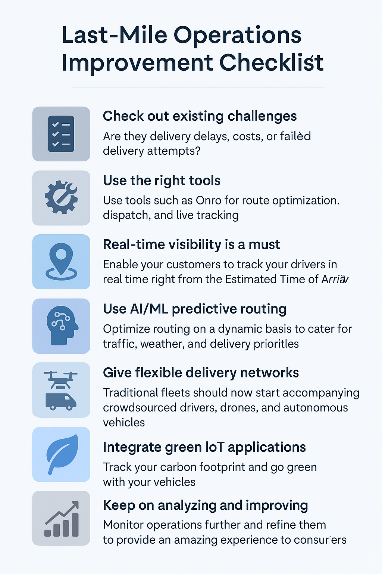
Last-mile delivery is something that cannot be compromised anymore for a business. This checklist visual serves as a tool for businesses intent on streamlining operations to maximize the customer experience. First and foremost, name your bottlenecks, delays, or failed deliveries. Then go ahead and use the latest dispatching-and-ride real-time tools such as Onro. And give your customers full visibility until they receive it on their doorsteps.
Route with AI/ML that responds in real time to any condition that may arise, then increase flexibility via crowdsourcing or potential autonomous means. Tie in IoT for green logistics, so that carbon footprint tracking is tied to sustainable development.
Of course, be sure that performance monitoring and performance improvement are tracked against databases all the way through-always a positive recipe for last-mile logistics that operates quickly, smartly, and is environment-friendly.
FAQ | Last-Mile Strategy
Last mile delivery is about transportation activities at the end of the line-from the local distribution center to the customer’s front door. Last-Mile Strategy is considered the larger picture, any set of tactics to optimize that delivery process, such as route optimization, use of technology, and improvements to the customer experience.
To better optimize the last mile for small businesses, route optimization software should be applied. It would offer real-time tracking, flexible delivery options, and community-based driver rating during peak periods. Also, it might be worth investing in predictive analytics that will forecast delays and demand spikes.
Onro might be the best software tool by 2025. This solution offered excellent sets of tools that include AI/ML for route optimization, real-time tracking of drivers and dispatching, predictive ETA, and analytics dashboards to continuously improve logistics and customer experience.
Conclusion
In summary, last-mile strategy in 2025 means more about keeping an open mind about the latest technologies and smart operational strategies. Consider AI, whether it be in route optimization or real-time tracking; sustainability or flexible delivery networks: amongst others, these factors contribute to operational efficiency, cost-savings, and customer satisfaction.
Onro offers a full toolbox in one dashboard:
- Track drivers in real time
- Dispatch and automatically optimize routes
- Provide branded experiences for customers
- Analyze your operations to improve them
Ready to fast-track delivery and scale bet right? Gain full control of your last-mile operations for some fun; book your free demo with Onro today!
Try Onro for Free
Get your free access to the Onro All-in-one Last Mile Delivery Software.
